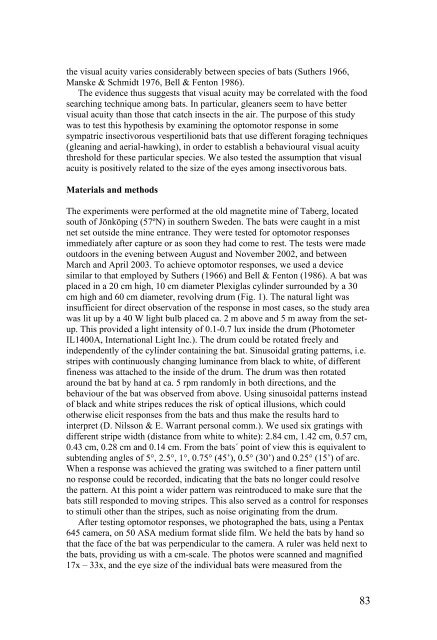Vision in echolocating bats - Fladdermus.net
Vision in echolocating bats - Fladdermus.net
Vision in echolocating bats - Fladdermus.net
You also want an ePaper? Increase the reach of your titles
YUMPU automatically turns print PDFs into web optimized ePapers that Google loves.
the visual acuity varies considerably between species of <strong>bats</strong> (Suthers 1966,<br />
Manske & Schmidt 1976, Bell & Fenton 1986).<br />
The evidence thus suggests that visual acuity may be correlated with the food<br />
search<strong>in</strong>g technique among <strong>bats</strong>. In particular, gleaners seem to have better<br />
visual acuity than those that catch <strong>in</strong>sects <strong>in</strong> the air. The purpose of this study<br />
was to test this hypothesis by exam<strong>in</strong><strong>in</strong>g the optomotor response <strong>in</strong> some<br />
sympatric <strong>in</strong>sectivorous vespertilionid <strong>bats</strong> that use different forag<strong>in</strong>g techniques<br />
(glean<strong>in</strong>g and aerial-hawk<strong>in</strong>g), <strong>in</strong> order to establish a behavioural visual acuity<br />
threshold for these particular species. We also tested the assumption that visual<br />
acuity is positively related to the size of the eyes among <strong>in</strong>sectivorous <strong>bats</strong>.<br />
Materials and methods<br />
The experiments were performed at the old mag<strong>net</strong>ite m<strong>in</strong>e of Taberg, located<br />
south of Jönköp<strong>in</strong>g (57ºN) <strong>in</strong> southern Sweden. The <strong>bats</strong> were caught <strong>in</strong> a mist<br />
<strong>net</strong> set outside the m<strong>in</strong>e entrance. They were tested for optomotor responses<br />
immediately after capture or as soon they had come to rest. The tests were made<br />
outdoors <strong>in</strong> the even<strong>in</strong>g between August and November 2002, and between<br />
March and April 2003. To achieve optomotor responses, we used a device<br />
similar to that employed by Suthers (1966) and Bell & Fenton (1986). A bat was<br />
placed <strong>in</strong> a 20 cm high, 10 cm diameter Plexiglas cyl<strong>in</strong>der surrounded by a 30<br />
cm high and 60 cm diameter, revolv<strong>in</strong>g drum (Fig. 1). The natural light was<br />
<strong>in</strong>sufficient for direct observation of the response <strong>in</strong> most cases, so the study area<br />
was lit up by a 40 W light bulb placed ca. 2 m above and 5 m away from the setup.<br />
This provided a light <strong>in</strong>tensity of 0.1-0.7 lux <strong>in</strong>side the drum (Photometer<br />
IL1400A, International Light Inc.). The drum could be rotated freely and<br />
<strong>in</strong>dependently of the cyl<strong>in</strong>der conta<strong>in</strong><strong>in</strong>g the bat. S<strong>in</strong>usoidal grat<strong>in</strong>g patterns, i.e.<br />
stripes with cont<strong>in</strong>uously chang<strong>in</strong>g lum<strong>in</strong>ance from black to white, of different<br />
f<strong>in</strong>eness was attached to the <strong>in</strong>side of the drum. The drum was then rotated<br />
around the bat by hand at ca. 5 rpm randomly <strong>in</strong> both directions, and the<br />
behaviour of the bat was observed from above. Us<strong>in</strong>g s<strong>in</strong>usoidal patterns <strong>in</strong>stead<br />
of black and white stripes reduces the risk of optical illusions, which could<br />
otherwise elicit responses from the <strong>bats</strong> and thus make the results hard to<br />
<strong>in</strong>terpret (D. Nilsson & E. Warrant personal comm.). We used six grat<strong>in</strong>gs with<br />
different stripe width (distance from white to white): 2.84 cm, 1.42 cm, 0.57 cm,<br />
0.43 cm, 0.28 cm and 0.14 cm. From the <strong>bats</strong>´ po<strong>in</strong>t of view this is equivalent to<br />
subtend<strong>in</strong>g angles of 5°, 2.5°, 1°, 0.75° (45’), 0.5° (30’) and 0.25° (15’) of arc.<br />
When a response was achieved the grat<strong>in</strong>g was switched to a f<strong>in</strong>er pattern until<br />
no response could be recorded, <strong>in</strong>dicat<strong>in</strong>g that the <strong>bats</strong> no longer could resolve<br />
the pattern. At this po<strong>in</strong>t a wider pattern was re<strong>in</strong>troduced to make sure that the<br />
<strong>bats</strong> still responded to mov<strong>in</strong>g stripes. This also served as a control for responses<br />
to stimuli other than the stripes, such as noise orig<strong>in</strong>at<strong>in</strong>g from the drum.<br />
After test<strong>in</strong>g optomotor responses, we photographed the <strong>bats</strong>, us<strong>in</strong>g a Pentax<br />
645 camera, on 50 ASA medium format slide film. We held the <strong>bats</strong> by hand so<br />
that the face of the bat was perpendicular to the camera. A ruler was held next to<br />
the <strong>bats</strong>, provid<strong>in</strong>g us with a cm-scale. The photos were scanned and magnified<br />
17x – 33x, and the eye size of the <strong>in</strong>dividual <strong>bats</strong> were measured from the<br />
83


